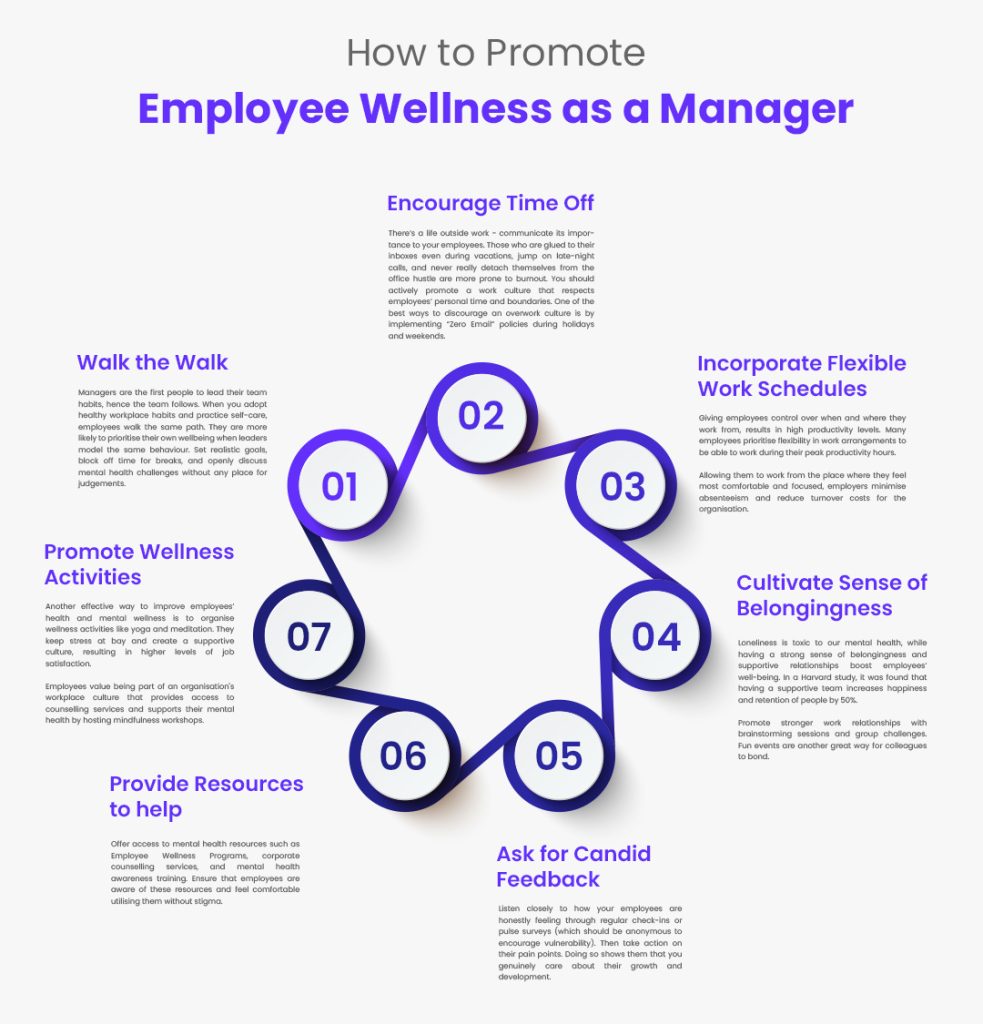
When employees are treated like work machines, they treat the organisation back with low performance and poor results. That’s the sad reality of many workplaces. Due to which, approximately 76% of employees experience burnout and incur $300 billion costs in lost productivity.
With more than 40% of employees feeling like leaving their jobs, it’s time managers prioritise and invest in employee’s holistic well-being.
In this blog, we discuss 7 ways to invest in employee wellness and cultivate a supportive work culture.
Importance of Employee Well-being
There are days (weeks… even months) when employees feel completely drained and unmotivated.
This could be an outcome of personal stress. Or work demands that have them pulling all-nighters more often than anticipated. Either way, poor work-life balance takes a hit on their mental health and overall well-being.
In the current generation’s always-on work culture, supporting employee well-being is no longer a nice-to-have perk. It’s a must-have. After all, our organisations are only as successful as the teams powering them.
Here’s why high-performing managers stay invested in employees’ mental well-being:
Happy and Engaged Employees
Employees who are stressed and unhappy never show up as their best selves and fail to bring their A-game to work consistently. Only when employees feel their overall health and mental well-being are supported by managers, they unlock their true potential and ability to execute at an exceptionally high level each day.
Higher Engagement and Productivity
Employees who feel their employer cares about their wellbeing are 38% more engaged. At SBL Corp, one of our core values is treating our employees like people first, not just resources to be exploited. By keeping their wellbeing top of mind, we’ve managed to foster a culture of trust, resilience, and mutual care. It’s a huge part of why our team is engaged and motivated to go above and beyond.
Better Retention, Less Turnover
People don’t leave companies, they leave managers and work culture. By nurturing employees’ health and wellness, you create a positive environment that top talent wants to be a part of. Employee wellness initiatives reduce employee turnover by 59%!
How to Promote Employee Wellness as a Manager?
Employees are also human with emotional and psychological needs. They desire a workplace to stay happy, healthy, safe, and secure.
Following are the 7 proven strategies to promote employee wellness in your workplace:
Walk the Walk
Managers are the first people to lead their team habits, hence the team follows.
When you adopt healthy workplace habits and practice self-care, employees walk the same path. They are more likely to prioritise their own wellbeing when leaders model the same behaviour.

Set realistic goals, block off time for breaks, and openly discuss mental health challenges without any place for judgements.
Encourage Time Off
There’s a life outside work – communicate its importance to your employees. Those who are glued to their inboxes even during vacations, jump on late-night calls, and never really detach themselves from the office hustle are more prone to burnout. You should actively promote a work culture that respects employees’ personal time and boundaries.
One of the best ways to discourage an overwork culture is by implementing “Zero Email” policies during holidays and weekends. Ensure most work is done during work days and office timings for everyone to enjoy time off to themselves.
Incorporate Flexible Work Schedules
Giving employees control over when and where they work from, results in high productivity levels. Many employees prioritise flexibility in work arrangements to be able to work during their peak productivity hours.
Allowing them to work from the place where they feel most comfortable and focused, employers minimise absenteeism and reduce turnover costs for the organisation.
Cultivate Sense of Belongingness
Loneliness is toxic to our mental health, while having a strong sense of belongingness and supportive relationships boost employees’ well-being. In a Harvard study, it was found that having a supportive team increases happiness and retention of people by 50%.
Promote stronger work relationships with brainstorming sessions and group challenges. Fun events are another great way for colleagues to bond.
Ask for Candid Feedback
Listen closely to how your employees are honestly feeling through regular check-ins or pulse surveys (which should be anonymous to encourage vulnerability). Then take action on their pain points. Doing so shows them that you genuinely care about their growth and development.
Provide Resources to help
Offer access to mental health resources such as Employee Wellness Programs, corporate counselling services, and mental health awareness training. Ensure that employees are aware of these resources and feel comfortable utilising them without stigma.
Promote Wellness Activities
Another effective way to improve employees’ health and mental wellness is to organise wellness activities like yoga and meditation. They keep stress at bay and create a supportive culture, resulting in higher levels of job satisfaction.
Employees value being part of an organisation’s workplace culture that provides access to counselling services and supports their mental health by hosting mindfulness workshops.
Summary
A high-performing manager knows the importance of putting employee wellness ahead of everything in the organisation in building a safe and healthy working environment.
It doesn’t have to involve extravagant perks or pricey employee wellbeing initiatives. Sometimes the simplest actions of empathy and care go a long way.
Consider this as a wake-up call to prioritise your team’s well-being today!
Follow me on LinkedIn
Frequently Asked Questions
1. Why is employee well-being a major concern?
Employee well-being is a major concern as it has a direct impact on their productivity levels, engagement rates, and overall workplace satisfaction. By introducing well-being initiatives, managers can create a positive and healthy workplace for employees to thrive both personally and professionally.
2. How to boost employee wellbeing?
Key strategies to promote employee well-being include leading by example, allowing time off, providing wellness resources, and creating a sense of community and belonging.
3. Why should managers normalise time off for self-care?
There’s a life outside professional commitments. Vacations and days off are essential to prevent burnout and keep stress at bay. Sufficient time off gives people an opportunity to mentally recharge and rejuvenate and to come back to work at their full potential.
4. Why is flexibility important for employee wellness?
Flexible work arrangements make it easier for employees to integrate their professional and personal lives in a better way to accommodate their needs and responsibilities outside their work.



